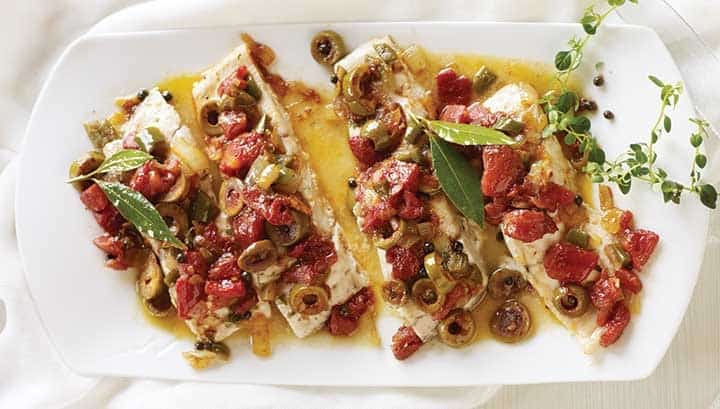
Sustainable protein with omega-3s
Also known as Asian sea bass, sustainable sea bass or giant perch, a 5-ounce portion of barramundi has 137 calories (half that of salmon), 2½ grams total fat, negligible saturated fat and 76 milligrams of cholesterol. It’s also an excellent source of high-quality protein. And when it comes to omega-3 fatty acids, barramundi really shines, providing 600 to 800 milligrams of omega-3s (nearly half the weekly amount recommended in the 2010 Dietary Guidelines for Americans).
Heart-healthy omega-3s are thought to work on multiple levels—they fight inflammation, lower triglycerides, reduce arrhythmias and slow the buildup of arterial plaque. Studies show consuming at least 250 milligrams of omega-3s could reduce the risk of sudden cardiac death by 35 percent and overall fatal coronary events by 17 percent. Other research shows omega-3s may provide benefits to individuals with arthritis, depression and memory loss associated with aging, and they are associated with a lower incidence of age-related macular degeneration. Preliminary data suggests omega-3 fatty acids may also play a role in protecting against Alzheimer’s disease and dementia.
Women who are pregnant or breastfeeding are encouraged to eat fish like barramundi because omega-3 fats have been associated with improved cognitive development in infants. Plus, barramundi farmed in the U.S. is low in mercury and PCBs—contaminants that may impair a fetus’ nervous system development.
How to Cook Barramundi
A relative newcomer to the American table, barramundi has quickly gained favor among consumers. A thick, pure white, flaky fish reminiscent of Chilean sea bass, barramundi has a buttery-smooth, rich and mild taste that complements a variety of flavor profiles—from Mediterranean ingredients like fennel and tomatoes, or oranges and olives, to soy sauce and ginger, or Thai basil and sriracha.
You can simmer it in a light curry, serve over sweet corn risotto, sauté with artichokes, baby leeks and mushrooms, or top with a spicy salsa. Or keep it simple: lemon and herbs, or olive oil and garlic.
Most barramundi on the market is sold fresh from frozen or as frozen individual fillets, although some ethnic markets may carry live barramundi. Delicious steamed, baked, broiled or blackened, barramundi works well in stews, chowders and stir-frys. It also takes smoke well, making it a good candidate for the grill.
Barramundi for Professional Kitchens
In addition to its culinary versatility, chefs prize barramundi for its price and performance — this sturdy fish holds up well on a steam table. Barramundi costs much less than comparable fish like red snapper, grouper and black bass, and lends itself to lower-cost preparation methods such as stews and curries.
Barramundi is available fresh or frozen to food service operations. You can find farm-raised fresh barramundi round, live or filleted. Live fish typically range from 1 to 1 ¾ pounds in size. Round whole fish are available in 25-pound packs and shipments are delivered daily from Boston. Boneless fillets (3 to 5 ounces or 5 to 7 ounces) come in 5- and 10-pound cases. Frozen fillets are sold skin-on or skin-off in 10-pound cases, in a variety of fillet sizes. Wild-caught barramundi from Indonesia are available in sizes from 16 to 48 ounces and are sold skin-on in 15-pound cases.
